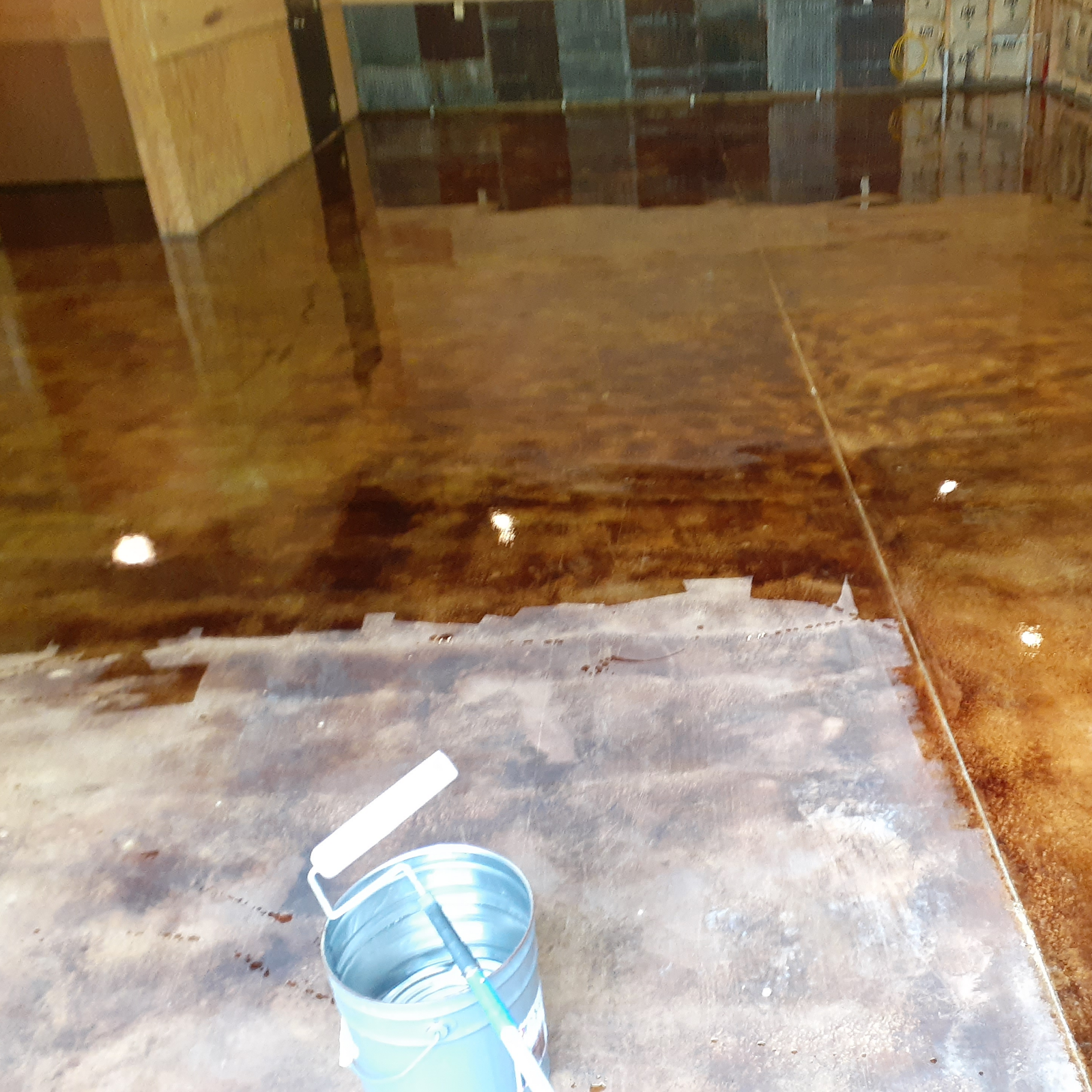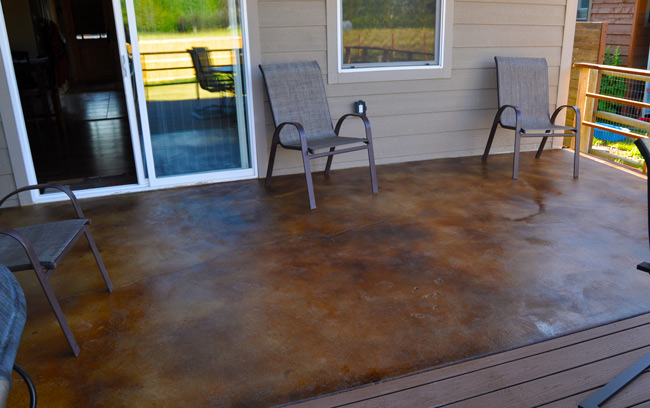Recognizing the Different Kinds Of Stained Concrete for Your Next Task
Stained concrete deals numerous options that satisfy various visual and practical needs. Each type presents distinctive attributes that affect the last appearance and resilience of the surface area. Understanding these differences is crucial for any individual preparing a task. From abundant, chemical reactions of acid-based stains to the vivid harmony of solid shade stains, the options can significantly impact the end result. What aspects should one consider when choosing the excellent discolor for their specific requirements?
Introduction of Stained Concrete
Stained concrete functions as a versatile flooring choice that can enhance the aesthetic charm of various rooms. This technique entails applying a coloring representative to the surface of existing concrete, permitting for a wide spectrum of style opportunities. Stained concrete is popular in both property and business atmospheres, offering a resilient and low-maintenance remedy that can simulate the appearance of all-natural products like rock or ceramic tile.
The discoloration process can be carried out making use of water-based or solvent-based items, each supplying distinct visual results. The final appearance is affected by aspects such as the original concrete surface area, the sort of tarnish utilized, and the application method. Stained concrete not just improves interiors and exteriors yet additionally advertises sustainability by rejuvenating existing concrete structures. Because of this, it has gotten traction amongst homeowners and developers seeking both capability and style in their flooring options.
Acid-Based Stains: Qualities and Benefits

Special Shade Variants
Concrete surfaces can transform drastically with the application of acid-based stains, which provide a rich palette of one-of-a-kind shade variants. These stains pass through the concrete, responding chemically to produce vivid planet tones that vary from deep browns and reds to soft environment-friendlies and blues. The resulting colors are often variegated, developing a natural, marble-like look that improves the concrete's personality. Each application yields distinct outcomes as a result of variants in the concrete's composition and the staining technique used, making every project unique. Furthermore, acid-based stains can be layered or integrated with various other techniques to create customized layouts, permitting personal expression. This convenience makes acid-based stains a preferred choice for both property and business applications.
Chemical Responses Explained
While several aspects add to the effectiveness of acid-based stains, the underlying chain reaction play a crucial duty in their distinct characteristics and benefits. These stains mainly contain water, acid, and metallic salts. When related to concrete, the acid responds with the calcium hydroxide in the concrete, producing a chemical improvement that leads to irreversible color modifications. The metallic salts pass through the surface and bond with the concrete, enabling for a large range of shades and tones. This reaction not just enhances aesthetic charm yet also gives durability, making the shade immune to fading and wear. In addition, acid-based stains can produce a variegated surface that imitates all-natural stone, further enhancing their popularity for ornamental concrete applications.
Surface Preparation Relevance
Attaining suitable results with acid-based stains hinges on extensive surface prep work. This vital action guarantees that the concrete surface area is tidy, without contaminants, and properly profiled for optimal tarnish absorption. Any existing sealers, dust, or oils can prevent the chemical reaction that produces the wanted shade and surface, causing irregular or patchy outcomes.
Before applying the tarnish, the concrete ought to be mechanically cleaned up or stress cleaned, complied with by an extensive examination for splits or imperfections that might call for repair service. Additionally, verifying the surface area is adequately dried will certainly improve tarnish adherence. By prioritizing these preparatory procedures, the longevity and vibrancy of acid-based stains can be substantially boosted, causing a more cosmetically pleasing and resilient finish.
Water-Based Stains: Features and Advantages

Water-based stains permeate the concrete, offering a more clear surface that highlights the natural appearance and variants of the surface area below. They are readily available in a broad array of shades, permitting creative versatility in style. In addition, water-based stains are much easier to clean up, requiring just water and soap, which streamlines the application process.
Their quick drying out time improves effectiveness, making them a functional choice for both do it yourself lovers and specialists. Overall, water-based stains give an enticing mix of visual flexibility and straightforward buildings, making them a preferred alternative for concrete improvement jobs.
Solid Shade Stains: Dynamic Alternatives for a Bold Appearance
Solid color stains supply an efficient service for those looking for to produce a strong and dynamic visual on concrete surfaces. These stains offer a consistent coloration that can significantly boost the aesthetic allure of floors, patio areas, and driveways. Readily available in a broad spectrum of colors, strong color stains enable creative expression, satisfying different style preferences.
One of the crucial advantages of solid shade stains is their capability to conceal flaws, offering a fresh and polished want to maturing concrete - stained concrete company. In addition, their formula typically consists of UV-resistant buildings, making certain longevity and color retention also in severe weather
Application is straightforward, calling for marginal prep work of the concrete surface area. As soon as used, strong shade stains can be secured for added security and luster, more boosting their visual quality. With their lively alternatives, strong color stains are an excellent option for those intending for an impactful and cohesive design.
Semi-Transparent Stains: Achieving Depth and Dimension
Semi-transparent stains supply a distinct method to improving concrete surface areas by providing depth and dimension with numerous shade options. Comprehending the application techniques is important for attaining the wanted impact, while appropriate maintenance techniques assure durability. This area will discover these key facets to optimize the benefits of semi-transparent discoloration.
Color Options Available
A variety of shade options exists for semi-transparent stains, permitting homeowners and designers to enhance the all-natural elegance of concrete surfaces. These stains can be found in a selection of tones, from earthy tones like browns and terracottas to vibrant shades such as blues and greens. The semi-transparent nature of these stains allows the underlying concrete to reveal through, developing an unique depth and dimension that can complement numerous style aesthetic appeals. Additionally, incorporating various shades can produce customized shades, allowing a customized search for each project. This adaptability makes semi-transparent stains a prominent selection for a fantastic read both exterior and interior applications, as they can integrate with surrounding aspects while adding aesthetic passion to ordinary concrete.
Application Strategies Discussed
To achieve the preferred depth and measurement with semi-transparent stains, appropriate application methods are essential. Surface area prep work is important; the concrete should be tidy and totally free of any kind of pollutants. This commonly entails power washing and fixing any cracks. Next, selecting the appropriate applicator, such as a sprayer, roller, or brush, can affect the last appearance. Sprayers permit a more even application, while rollers can assist accomplish appearance. It is essential to use the discolor in slim, also layers, allowing each layer to completely dry prior to including another. Manipulating the application technique, such as varying stress or using various devices, can create unique impacts. Finally, securing the stained surface improves the vibrancy of the colors while offering protection.
Maintenance Finest Practices
Routine upkeep is necessary for preserving the appeal and integrity of surface areas treated with semi-transparent stains. To keep these surface areas, routine cleaning is vital. Using a pH-neutral cleaner and a soft-bristle broom will assist get rid of dirt and particles without damaging the discolor. It is recommended to prevent severe chemicals, as they can weaken the discolor's appearance. Additionally, periodic resealing every one to three years can safeguard versus wear and fading. This process entails cleaning up the surface area completely and applying a compatible sealer developed for stained concrete. Property owners must additionally check for any indications of staining or damages and address these concerns quickly to guarantee lasting vibrancy and longevity. Following these ideal techniques will certainly enhance the total life-span of semi-transparent stained surfaces.
Effects and Methods: Tailoring Your Stained Concrete
Customizing stained concrete includes a variety of techniques that enhance both looks and performance. Among these techniques, layering various stain colors can develop deepness next and complexity, enabling special visual impacts. Methods such as acid staining give a variegated look, while water-based stains offer an extra consistent appearance.
Additionally, incorporating decorative patterns, such as stenciling or engraving, can further personalize the surface, including elaborate layouts that accommodate individual preferences. Texturing the concrete, whether through marking or mop coatings, introduces tactile elements that not just enhance grasp however likewise improve visual rate of interest.
Furthermore, using sealants can enhance the color vibrancy and offer defense against wear. Personalization strategies prolong beyond mere color; they can change a basic concrete slab into a magnificent prime focus, making it appropriate for both household and business rooms. With careful choice of effects and methods, stained concrete can achieve a truly tailored look.
Maintenance and Durability of Stained Surfaces
Stained concrete surface areas are recognized for their longevity and visual charm, keeping their honesty is vital for making sure durability. Normal cleaning is essential; sweeping and wiping with a pH-neutral cleaner assists stop dirt buildup and discoloration. In addition, applying a sealant every few years can secure the surface area from moisture, chemicals, and UV damages, therefore enhancing its life expectancy.
It is additionally vital to address any kind of splits or chips without delay. Tiny repairs can mitigate more deterioration, protecting the aesthetic and structural top quality of the surface area. For exterior stained concrete, seasonal maintenance, such as removing snow and ice, is needed to avoid surface damages from freeze-thaw cycles.
Regularly Asked Inquiries
Can I Stain Existing Concrete Surfaces or Only Brand-new Ones?
The question of whether existing concrete surfaces can be stained emerges frequently. It is indeed feasible to discolor both new and old concrete, offered the surface area is properly prepared and without impurities for optimal adhesion.
The length of time Does the Staining Refine Typically Take?
The discoloration procedure commonly takes one to 3 days, relying on elements such as surface preparation, type of stain, and climate problems. stained concrete. Healing time might extend beyond initial application, affecting the total duration considerably
Is Stained Concrete Safe for Outdoor Use?
Stained concrete is typically secure for outside use, provided it is effectively sealed. This sealing secures versus dampness and UV damages, making sure sturdiness and safety, while likewise boosting the aesthetic charm of outside spaces.
Can I Apply Several Spot Layers for Different Effects?
Using numerous discolor layers can accomplish different results official source on stained concrete. However, it is necessary to guarantee compatibility in between stains and enable correct drying time in between applications to avoid unexpected responses or staining.
Exist Any Type Of Color Limitations for Stained Concrete?
Shade restrictions for stained concrete mainly depend upon the kind of discolor made use of, with water-based stains using a more comprehensive combination compared to acid-based stains. stained concrete company. Accomplishing dynamic shades might need cautious choice and application strategies.